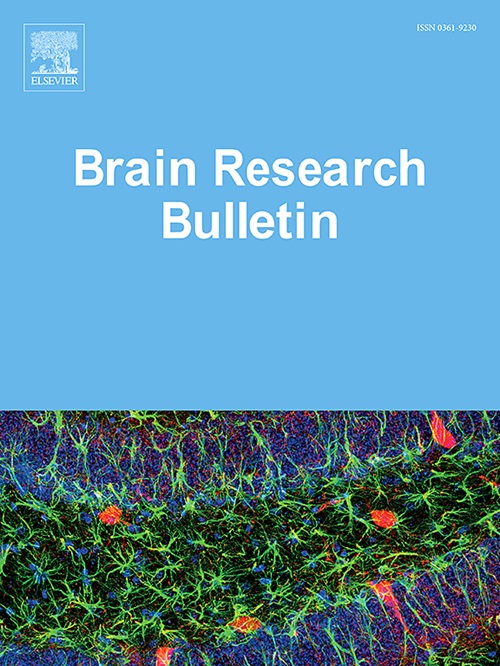隐蔽性听力损失小鼠听觉皮层兴奋抑制失衡导致噪声环境下声音识别障碍
IF 3.5
3区 医学
Q2 NEUROSCIENCES
引用次数: 0
摘要
噪声诱发的隐蔽性听力损失(HHL)是一种由中度噪声暴露引起的听力功能障碍。临床表现为在嘈杂环境中语音识别障碍,而听力阈值仍在正常范围内。噪音暴露导致语音识别障碍的机制尚不清楚。本研究旨在探讨HHL小鼠听觉皮层的兴奋-抑制状态及其在嘈杂环境下声音识别障碍中的作用。以110分贝(dB)直升机噪声2 h诱导小鼠HHL模型,采用声音识别-回避决策(SRAD)行为测试评价其声音识别能力。观察大鼠听觉皮层兴奋性神经元的激活水平及谷氨酸囊泡转运蛋白1 (VGluT1)和谷氨酸脱羧酶67 (GAD67)的表达。小鼠给予α-氨基-3-羟基-5-甲基-4-异恶唑丙酸(AMPA)受体拮抗剂NBQX。结果显示HHL小鼠听觉皮层cFos表达增加,活化CaMKⅡ+神经元比例上调。此外,在80 dB噪声刺激下,VGluT1和GAD67的表达在2 h下呈不平衡增加。SRAD行为测试显示,HHL小鼠在安静条件下保持正常的声音识别能力,而在嘈杂环境下则没有。NBQX治疗改善了声音识别,但没有恢复正常状态。本研究提示HHL小鼠听觉皮层兴奋抑制失衡可能是声音识别障碍的直接原因。本文章由计算机程序翻译,如有差异,请以英文原文为准。
Excitation-inhibition imbalance in the auditory cortex causes sound recognition impairment in noisy environment in hidden hearing loss mice
Noise–induced hidden hearing loss (HHL) is a type of hearing dysfunction caused by moderate noise exposure. It is clinically manifested as speech recognition impairment in noisy environments while the hearing threshold remains within the normal range. The mechanism by which noise exposure causes speech recognition impairment remains unclear. This study aimed to investigate the excitation–inhibition status in the auditory cortex of HHL mice and its roles in sound recognition disability in noisy environments. A model of HHL in mice was induced using 110 decibels (dB) of helicopter noise for 2 h, the sound recognition–avoidance decision (SRAD) behavioral test was used to evaluate sound recognition ability. The activation level of excitatory neurons and the expression of vesicular glutamate transporter 1 (VGluT1) and glutamate decarboxylase 67 (GAD67) in the auditory cortex were observed. Mice were administered α-amino-3-hydroxy-5-methyl-4-isoxazolepropionic acid (AMPA) receptor antagonist NBQX. The results showed increased cFos expression in the auditory cortex of HHL mice and an upregulated ratio of activated CaMKⅡ+ neurons. Furthermore, the expression of VGluT1 and GAD67 increased in an imbalanced manner under an 80 dB noise stimulus for 2 h. The SRAD behavioral tests showed the HHL mice maintained normal sound recognition ability under quiet conditions but not in a noisy environment. The NBQX treatment improved sound recognition but did not restore normal status. This study suggested that the excitation–inhibition imbalance in the auditory cortex of mice with HHL might be the direct cause of sound recognition disorders.
求助全文
通过发布文献求助,成功后即可免费获取论文全文。
去求助
来源期刊

Brain Research Bulletin
医学-神经科学
CiteScore
6.90
自引率
2.60%
发文量
253
审稿时长
67 days
期刊介绍:
The Brain Research Bulletin (BRB) aims to publish novel work that advances our knowledge of molecular and cellular mechanisms that underlie neural network properties associated with behavior, cognition and other brain functions during neurodevelopment and in the adult. Although clinical research is out of the Journal''s scope, the BRB also aims to publish translation research that provides insight into biological mechanisms and processes associated with neurodegeneration mechanisms, neurological diseases and neuropsychiatric disorders. The Journal is especially interested in research using novel methodologies, such as optogenetics, multielectrode array recordings and life imaging in wild-type and genetically-modified animal models, with the goal to advance our understanding of how neurons, glia and networks function in vivo.
 求助内容:
求助内容: 应助结果提醒方式:
应助结果提醒方式:


